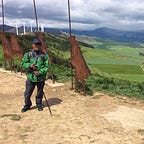Up Close with Sakura: An Immersive Photo Essay
Soon after 3,020 cherry trees arrived in America as a gift of friendship to the People of the United States from the People of Japan in 1912, cherry blossoms or Sakura as they are called in Japan, became synonymous with springtime in our nation’s capital. More than a century on, the tradition of viewing and experiencing the cherry blossoms — known as Hanami in Japan — has become a rite of passage into spring not only in the Tidal Basin of Washington D.C., but also in suburban parks such as Branch Brook in New Jersey as well as in far flung cities such as Macon, Georgia which reportedly has the largest concentration of flowering cherry trees in the nation.
Although the original gift of cherry trees from Japan consisted of a total of twelve different varieties, the most popular varieties of cherry blossoms in the U.S. today primarily derive from three species: Somei Yoshino along with its variant Akebono, Shidarezakura and Kwanzan.
Somei Yoshino (Yoshino Cherry)
Cultivated during the Edo Period in Tokyo, Somei Yoshinos are the most widespread cherry trees, not only in Japan, but in the U.S. as well.
Yoshino flowers initially emerge in the form of almost snow-white 5-petaled blossoms that gradually gain a pinkish tinge as they age.
Yoshino blossoms’ pristine and unencumbered appearance stems in part from the fact that leaves on the tree do not emerge until after the peak of the flowering season.
The look and feel of floating clouds render an ethereal beauty to the Yoshinos. Their unrestrained and free-flowing branches intensify this feeling.
Akebono Cherry (a Yoshino variant)
Akebono cherry trees are a mutation of the Yoshino cherry. They have single pale‑pink blossoms which differ from Yoshino blossoms in that they contain more than 5 petals. Akebonos’ masses of large, soft pink, semi-double flowers have earned them the nickname as the cherry trees with the largest blossoms.
Akebonos flower nearly simultaneously with the Yoshinos. With their soft pink color, they provide a great contrast to the snow-white Yoshino blossoms.
Shidarezakura (Weeping Cherry)
“Shidarezakura,” or “Weeping Cherry Tree” is the general term used to denote blossoms of trees with gently drooping branches. Weeping cherry trees start flowering around the same time as the Yoshino trees do in early spring.
Cascading blossoms in the manner of a waterfall give Weeping cherries considerable grace and beauty. While the feeling of serenity they evoke have endeared Weeping cherries to people in many countries, it has been especially so in Japan where contemplation and meditation play an important role in the culture. Various ancient weeping trees such as Neoya Usuzumi Zakura in Motosu City and Yamataka Jindai Zakura in Hokuto City attract large number of visitors each year.
The Weeping cherry blossoms have either single or double flowers and their colors range from dark pink to white. Weeping cherry flowers also vary in the number of their petals. They either have blossoms with five petals or have blossoms with more than five. Blossoms with more than five petals are known as Yaeshidarezakura and usually bloom a week or so after the 5-petaled ones. Their blossoms also last longer than that of their 5-petaled compatriots.
As shown above, Weeping cherries come in a broad range of colors: from deep pink to off-white to snow white.
While standard Weeping cherry trees usually reach heights of about 30 feet, their variant Snow Fountains grow to less than half to one-third of that height, earning the nickname Dwarf Weeping Cherry. They are one of the finest Weeping cherries to behold. As the blossoms envelop their cascading branches all the way to the ground, they conjure an image of a snow fountain.
Kwanzan Cherry
Kwanzans are the late-blooming cherries, showing up just about when Yoshinos and Weeping Cherries are past their prime. Those who are enamored with Kwanzans think that they are worth the wait. In clusters, the multi-layered Kwanzan blossoms indeed project a celebratory mood.
One Kwanzan blossom consists of as many as 30–50 pink petals. The fresh leaves eventually turn into coppery brown.
There is nothing subtle about Kwanzans. They do not shy away from flaunting their beauty especially since the space now primarily belongs to them with the passing or near passing of Yoshino and Weeping blossoms. There’s an air about them that gives the impression that they are perfectly entitled to steal the show.
Unquestionably, Kwanzans upright branches adorned with vibrant colors give an exuberant feel. The proximity of the branches to the ground offer an unusual level of intimacy and closeness almost inviting a conversation.
While most of the time Kwanzan blossoms appear in shades of soft to dark pink, there are exceptions as shown above. Here the blossoms have a soft and soothing feel with their white cottony look.
If the multilayered blossoms help to provide Kwanzans with lushness, they also help to accentuate their complexity and mystery. Zeroing in on Kwanzan flowers is like discovering age-old secrets hidden within them.
As I finish writing this essay, Yoshinos and Akebonos in my county in New Jersey seem to have arrived at the end of their blossoming cycle, while most of the Weeping cherries are just about past their prime. Kwanzans have been budding of late and their flowers are likely to descend on us in a week’s time.
Update: As of this second week of May 2022, Kwanzans blossoms have largely receded. A few of the blossoms are still hanging off the branches, but Kwanzans are well past their prime. Yet their fallen petals continue to cheer us with sublime beauty.
All photos displayed above were taken by the author and are from several towns and parks in Essex County, New Jersey. All Yoshino, Akebono and Weeping cherry photos are from the spring of 2022. Most of the Kwanzan photos are from the spring of 2021 with few exceptions.
